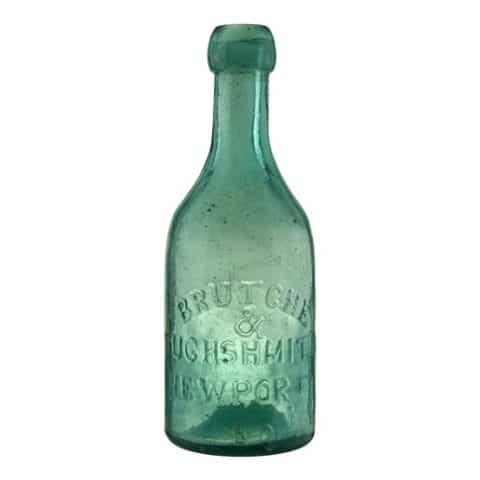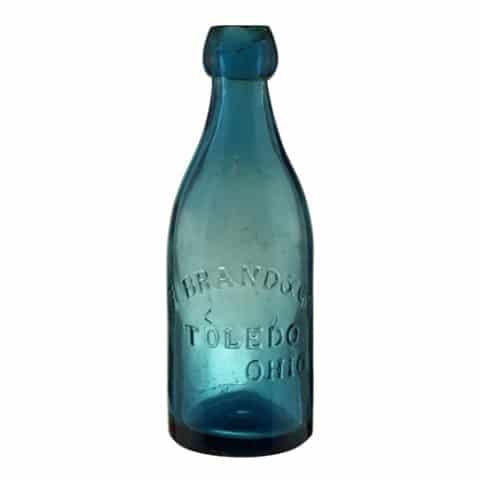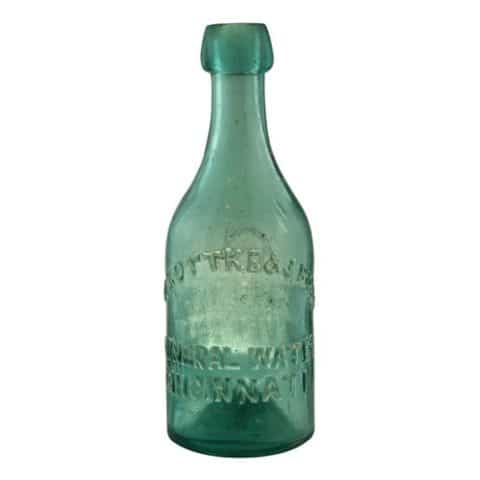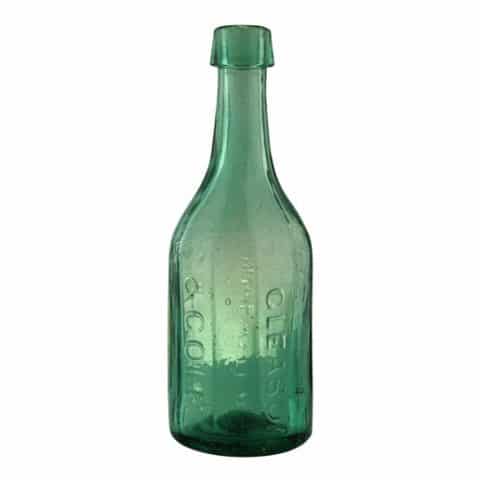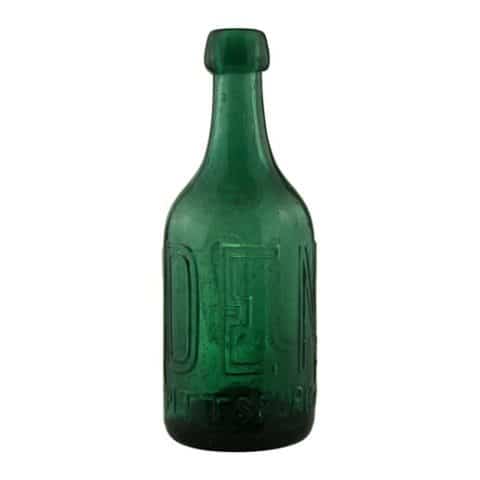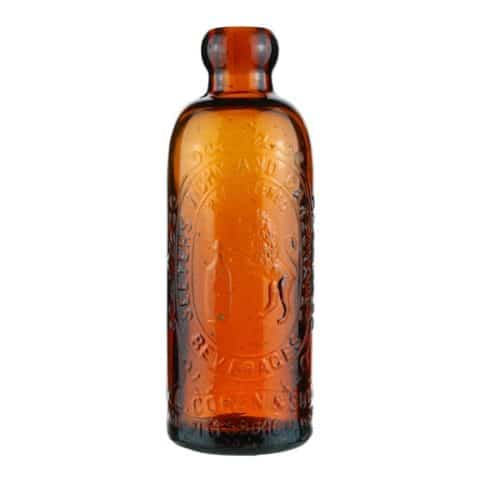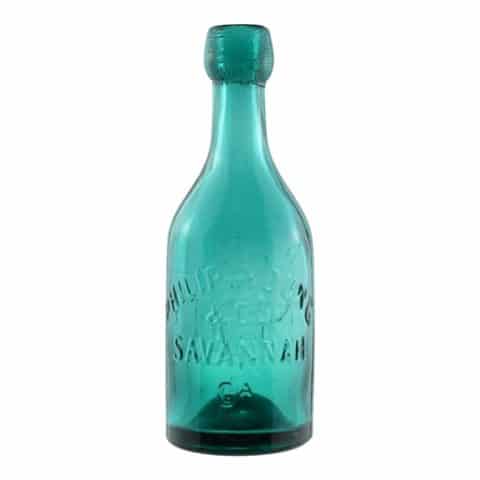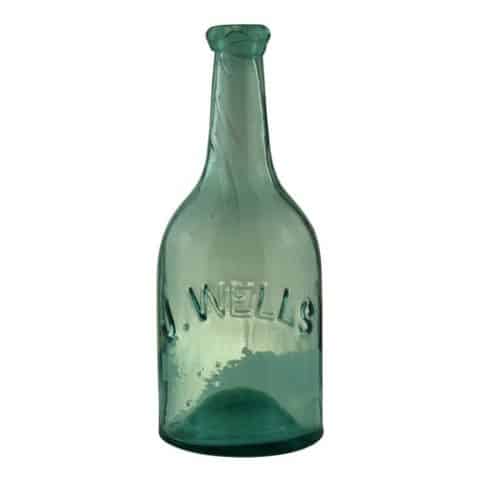Wm. Heiss Jr. Manufacturer of Superior Mineral and Soda Waters
Wm. Heiss Jr.
Manufacturer of Superior Mineral and Soda Waters
No. 213 Nor. 2d St. Phild.A
This Bottle to be Returned
William Heiss Jr., Philadelphia, Pennsylvania
Multi-Sided Medium Cobalt Blue Soda
Provenance: Doug Shutler Collection
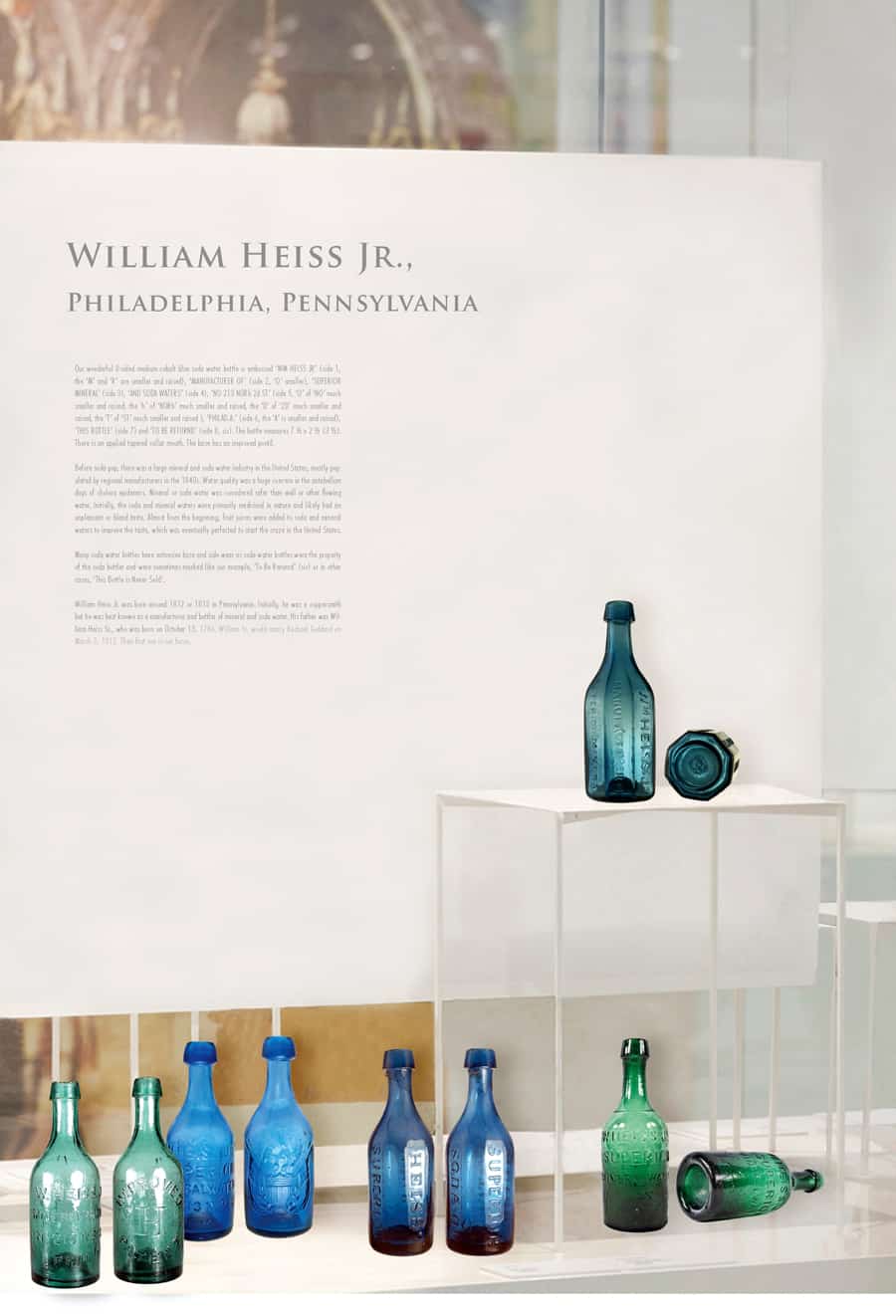
William Heiss Jr. was a leading mineral and soda water manufacturer of his time. He used his expertise as being a coppersmith to develop a “Mineral Water Apparatus” that he marketed broadly from his shop in Philadelphia which was marked with a sign of the Golden Eagle.

Our wonderful 8-sided medium cobalt blue soda water bottle is embossed ‘WM HEISS JR’ (side 1, the ‘M’ and ‘R’ are smaller and raised), ‘MANUFACTURER OF’ (side 2, ‘O’ smaller), ‘SUPERIOR MINERAL’ (side 3), ‘AND SODA WATERS’ (side 4), ‘NO 213 NORh 2d ST’ (side 5. ‘O’ of ‘NO’ much smaller and raised, the ‘h’ of ‘NORh’ much smaller and raised, the ‘D’ of ‘2D’ much smaller and raised, the ‘T’ of ‘ST’ much smaller and raised ), ‘PHILAD.A.’ (side 6, the ‘A’ is smaller and raised), ‘THIS BOTTLE’ (side 7) and ‘TO BE RETURND’ (side 8, sic). The bottle measures 7 ½ x 2 ½ (3 ½). There is an applied tapered collar mouth. The base has an improved pontil.
Before soda pop, there was a large mineral and soda water industry in the United States, mostly populated by regional manufacturers in the 1840s. Water quality was a huge concern in the antebellum days of cholera epidemics. Mineral or soda water was considered safer than well or other flowing water. Initially, the soda and mineral waters were primarily medicinal in nature and likely had an unpleasant or bland taste. Almost from the beginning, fruit juices were added to soda and mineral waters to improve the taste, which was eventually perfected to start the craze in the United States.
Many soda water bottles have extensive base and side wear as soda water bottles were the property of the soda bottler and were sometimes marked like our example, ‘To Be Returnd’ (sic) or in other cases, ‘This Bottle is Never Sold’.
William Heiss Jr. was born around 1812 or 1813 in Pennsylvania. Initially, he was a coppersmith but he was best known as a manufacturer and bottler of mineral and soda water. His father was William Heiss Sr., who was born on October 13, 1786. William Sr. would marry Rachael Goddard on March 3, 1812. Their first son is our focus.
Sometime in 1808, William Heiss Sr. and a partner, who was probably George Justice, purchased the coppersmith shop of Jesse Oat who was located at 184 North Second Street in Philadelphia. Justice had recently retired as City Commissioner and lived around the corner from the shop at 95 New Street.
By 1813, Justice had withdrawn from the firm and William Sr. was operating the business on his own. In 1813, Heiss moved his shop to 213 North Second Street. This was a longstanding metalworking operation with George Goddard who was a blacksmith, Samuel Alexander, silversmith, Phillip Apple, coppersmith, and Benjamin Scott, copper plate printer. William Heiss Jr. would eventually take over his father’s business around 1838 as William Sr. retired and was listed as a gentleman. He would die on October 10, 1846.

We start seeing advertisements from William Heiss Jr. as early as 1845 stating that he was a manufacturer of a Mineral Water Apparatus at the sign of the Golden Eagle and Fountain, No. 213 North Second Street, above Vine, in Philadelphia. His experience with copper and metalworking led him to develop a purer method to make mineral water. One series of advertisements that appeared in the Charleston Mercury in 1849 claimed that Wiliam Heiss Jr. had over 12 years of experience in the manufacturing of mineral water, operating fountains, and bottling.
Wm. Heiss Jr. in his advertising, stated that he had been to Paris and after “years of study and practical applications in the arts of Chemistry and Mechanics had developed the best and most complete Apparatus, for the Manufacture of Mineral Water in Bottles and Fountains, in the United States.” Besides selling the Mineral Water Apparatus he was selling generators, pumps, and fountains, ornamental urns, and pedestals for stands and counters for use in bars and hotels. He was selling his bottles at 31 ½ cents per dozen.
William Jr. continued to operate the coppersmith business during the later years of the 1840s when a devastating fire burned down much of the area around Vine and North Second Street on July 9, 1850. Heiss’ business was not spared and the following year the business was moved to Jillian above Willow Street.
William Jr. Heiss was probably the most successful mineral water manufacturer for a short period of years in Philadelphia. The competition was stiff with John Reynolds and Eugene Roussel and other upstarts like Andrew McFarland, William Riddle, George S. Twitchell. Roussel, in particular, was a competitor who had recently sold his perfumery to focus on the mineral water business. He is credited as being the first to flavor his waters with fruit juices or more accurately the first to bottle flavored soda water. Although neither is technically correct, he is the first to have made a success of it and thus deserves the credit as the “father of the American bottled soda water industry.”
Things start to deteriorate with Wm, Heiss and his business as the following notice appeared in the November 23, 1852 edition of the New York Tribune:
NOTICE TO SODA BOTTLERS – For sale cheap, six hundred gross of superior Mineral Water Bottles, all of them having been in use, therefore being superior to any new bottles. Will be sold on accommodating terms by WILLIAM HEISS, No. 213 North 2d-st., Philadelphia. Also, the large, superior Generator, made by myself and used in my own laboratory, with three cylinders, five Corking and Tying Benches, together with some other Machinery for the Soda business. The above generator is superior to any in the United States. I will also sell fifty Mineral Water Fountains, with Coolers, Connecting Pipes, Marble and Silver Pedestals, &c., and take part pay in good merchandise or real estate, unencumbered.
The attempt to sell his bottles and bottling business in New York was not successful and in the spring of the following year the following ad appeared in the May 15, 1853 edition of the Sunday Dispatch:
NOTICE – I HEREBY AUTHORIZE MR. EUGENE ROUSSEL to collect and take possession of all BOTTLES marked with my name, wherever found, having this day disposed of all my rights and interest in said Bottles to him. WILLIAM HEISS, May 10th, 1853. The undersigned having purchased of Mr. Wm. Heiss his entire stock of MINERAL WATER BOTTLES, all persons who are in possession of Bottles marked with the names of HEISS or ROUSSEL, will please give information at the Office, 44 Prune Street, when they will be sent for. EUGENE ROUSSEL
N. B – These Bottles, as well as my own, have been registered according to an Act of the Legislature of Pennsylvania, which “forbids all persons from buying, selling, using, filling or concealing any such Bottles so marked, under a penalty of 50 cents for each Bottle, for the first offense, and $5 for each subsequent offense, recoverable for the use of the Commonwealth.”
William Jr. appears to have withdrawn from the business over the next couple of years and it was taken over by his brother Goddard Heiss, who still used the carvings of the golden eagle over a fountain at the old stand on North Second Street.
At 46 years old, William Jr. died on May 15, 1858 of debility. Goddard continued to operate the business until 1866, when the premises were sold to Walter S. Stevenson & Company, who sold stoves.
The Wm. Heiss Jr. bottles date from about 1842. None of the bottles appear to be of Dyottville Glass Works manufacture. Dyottville was the manufacturer of his rival Eugene Roussel and Heiss utilized Union Glass Works for his later manufactured bottles. The earliest bottles have the appearance of South Jersey manufacture with their light green colors. The latest bottle also occurs in an aqua coloration. Heiss has a number of later bottles that include two eagle sodas and two multi-sided bottles. One of the eagle bottles and the eight-sided example come in a puce coloration. All are pictured here in the museum.

Primary Image: William Heiss Jr. soda water bottle imaged by the FOHBC Virtual Museum midwest studio led by Alan DeMaison.
Support: Extensive reference to Soda & Beer Bottles of North America, Tod von Mechow
Support: Reference to The American Pontiled Soda Database Project, Tod von Mechow
Support Images: Some secondary images from Jim Hagenbuch and Glass Works Auction. Emerald green example from Urban Remains.
Join the FOHBC: The Virtual Museum is a project of the Federation of Historical Bottle Collectors (FOHBC). To become a member.























